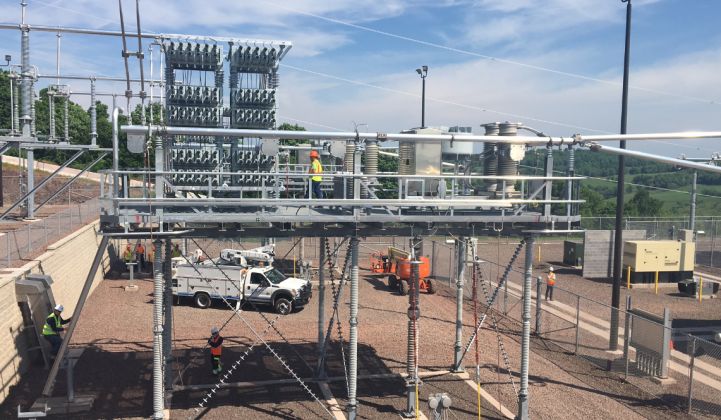New York has an ambitious goal of getting 50 percent of its electricity from renewable resources by 2030. To get there, the state will need to expand grid infrastructure to deliver renewable power from rural areas to load centers.
But the state won't always have to build new infrastructure -- it can do more with what it has.
The New York Power Authority and New York State Electric & Gas have just finished the first project that shows what is possible using existing infrastructure.
NYPA completed a $120 million transmission upgrade, called the Marcy South Series Compensation Project, that will move up to 440 megawatts of additional capacity from upstate, where there are abundant wind and hydro resources, to downstate cities.
“Marcy South is a prime example of how we can do more with existing assets,” Richard Kauffman, chair of energy and finance for New York, said in a statement.
Instead of building new transmission, NYPA and NYSEG collaborated to connect portions of their grids with ABB capacitor banks installed in the middle of the state. The project is a part of New York Governor Andrew Cuomo’s energy highway initiative that was established in 2012. The initiative calls for nearly $6 billion to modernize New York’s transmission system in order to enable more clean energy development.
“This is a traditional transmission upgrade that utilities are turning to more and more, when additional capacity is needed or when power needs to travel further to get to load centers,” said Ben Kellison, director of grid research at GTM Research.
Although announced before New York’s Reforming the Energy Vision initiative, the energy highway projects dovetail nicely with REV’s goal of providing more efficient, resilient and affordable energy.
Not only do capacitor banks reduce line losses and allow for more energy to move across the transmission lines, but they also give grid operators more visibility into transmission conditions so they can dispatch power with more accuracy.
New York currently has about 2 gigawatts of wind across the state. But New York's total transmission system could support about 6 gigawatts of wind without needing to build new transmission lines, said Gil Quiniones, CEO of NYPA. The current project is designed to prepare New York for the day when that threshold is passed.
A key tenet of REV is asking utilities and public agencies, such as NYPA, to better utilize the systems they already have. That includes transmission upgrades or non-wires alternative projects that use distributed energy or demand management to eliminate the need for centralized equipment upgrades.
REV also offers entities like NYPA an opportunity to think differently about their role in the state. NYPA is best known as a power generator and transmission authority, as it manages about one-third of New York’s high-voltage lines and oversees many hydro resources. But the Power Authority is also an energy services company, and it is working on increasingly complex behind-the-meter projects, and building microgrids like the one at Rikers Island.
It’s not just NYPA that is being called upon to reinvent its role in New York’s energy ecosystem. Earlier this month, the New York State Energy Research and Development Authority (NYSERDA) announced it would participate in an auction later this year for the offshore wind energy lease off of Long Island. NYPA and Con Edison have already done some initial assessments at the site, and NYPA will support NYSERDA’s bid.
NYPA’s assessment of the site found it could produce up to 700 megawatts of wind energy. If the site is built out to support that amount of capacity, it would be one of the largest wind farms in the world -- similar to the size of the London Array, and far larger than the first U.S. offshore wind farm being built off the coast of Rhode Island, which will be 30 megawatts.



